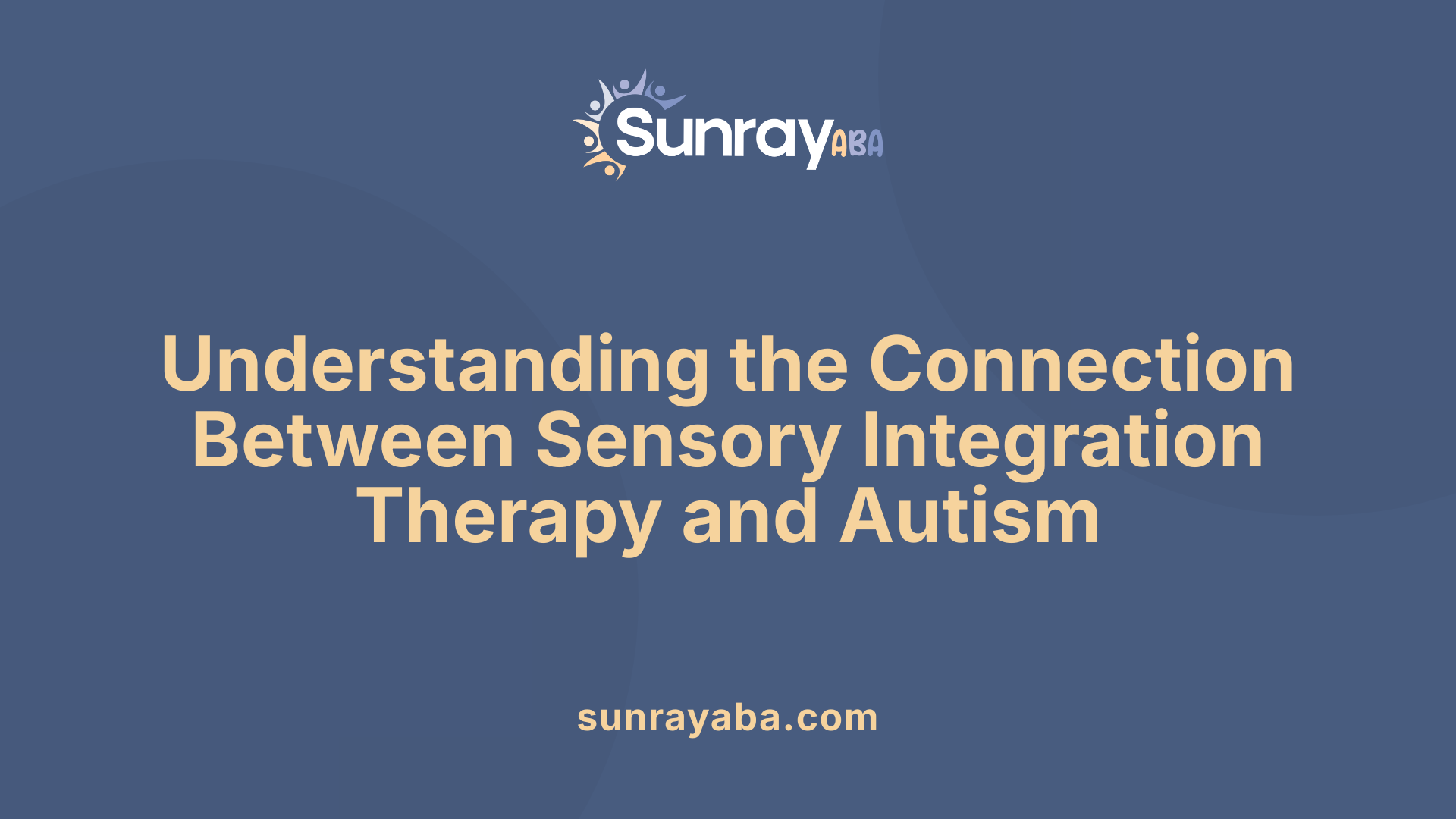Sensory Integration Therapy & Autism

Understanding Sensory Integration Therapy and Its Relevance to Autism
Sensory integration therapy (SIT), also known as Ayres Sensory Integration (ASI), is a specialized, play-based therapeutic approach developed to support individuals, especially children with autism, who face sensory processing difficulties. Rooted in neuroplasticity, SIT aims to improve the brain's ability to interpret sensory information through carefully designed activities. Though widely adopted, current scientific evidence on SIT’s effectiveness remains limited and often inconclusive, prompting ongoing research to clarify its role within autism interventions.
Foundations and Principles of Sensory Integration Therapy

What is sensory integration therapy and what are its principles?
Sensory integration therapy (SIT), also called Ayres Sensory Integration (ASI), is a child-centered, play-based approach designed to help children with sensory processing difficulties, especially those with autism, better interpret and respond to sensory stimuli. It focuses on active engagement, where children participate in tailored activities that stimulate their senses, such as touch, movement, balance, and hearing.
The core idea of SIT is that providing carefully structured sensory experiences can facilitate the brain's neuroplasticity—the ability of the nervous system to reorganize and adapt. Trained occupational therapists evaluate each child's sensory sensitivities and create individualized intervention plans. These plans often include activities like swinging, bouncing, or climbing, aimed at challenging the child's sensory processing just enough to promote improvement without overwhelming them.
A fundamental principle of SIT is the 'just right challenge,' which involves offering stimuli that are neither too easy nor too difficult, encouraging the child to stay engaged and learn. This helps to improve their sensory-motor integration, leading to better motor skills, emotional regulation, and behavioral responses.
Equal importance is placed on collaborative goal-setting with families and caregivers. Therapists work closely with parents, educators, and children to set realistic, meaningful goals that focus on everyday functioning, such as participating in play or self-care routines.
Overall, sensory integration therapy aims to organize the central nervous system, modulate sensory responses, and improve the child's ability to navigate their environment more effectively. While current research evidence is limited and of variable quality, SIT remains a widely used intervention, with the potential to positively influence behavioral and functional outcomes when properly tailored and delivered.
Blurring Lines: How SIT Applies to Autism Spectrum Disorder

How does sensory integration therapy relate to autism?
Sensory integration therapy (SIT) is a specialized intervention used to address sensory processing differences common in children with autism spectrum disorder (ASD). Many autistic children experience difficulties in interpreting sensory stimuli, which can cause behaviors like overreaction (hypersensitivity) or underreaction (hyposensitivity) across senses such as touch, sound, sight, and movement.
Developed in the 1970s by occupational therapist A. Jean Ayres, SIT involves engaging children in playful, sensory-motor activities that target specific sensory challenges. Trained therapists use tools like swings, trampolines, weighted vests, brushing protocols, and other equipment to stimulate visual, tactile, vestibular, and proprioceptive senses. These activities are personalized based on the child's unique sensory profile to encourage better processing and response to sensory input.
The rationale behind SIT is that improving sensory processing can help children better participate in daily activities, regulate their emotions, and reduce problematic behaviors. For example, activities that provide balanced vestibular and proprioceptive input may promote self-regulation, attention, and motor coordination.
While some research and clinical reports highlight potential benefits of SIT—such as improved goal attainment and reduced behaviors like self-harm—scientific evidence remains limited. Systematic reviews have largely concluded that current studies are of low quality, with many methodological flaws. Nevertheless, SIT remains widely used, especially by occupational therapists, because of its intuitive approach and individualized focus.
In summary, SIT is related to autism as a tailored therapeutic approach aimed at improving how children with ASD process sensory information. Although promising in some cases, more rigorous research is necessary to firmly establish its effectiveness and long-term benefits.
Development of SIT based on sensory dysfunctions in autism
The development of sensory integration therapy was inspired by the understanding that sensory processing issues are integral to many autism symptoms. Autism is associated with dysfunctions in neural processing of sensory stimuli, often leading to behaviors such as rocking, spinning, hand-flapping, or avoidance of certain stimuli.
Ayres's work in the mid-20th century identified that these behaviors could be linked to the brain's difficulty organizing sensory input. This insight led to the creation of sensory-focused activities that aim to help the central nervous system better interpret incoming sensory information.
Over time, SIT evolved into a structured, play-based therapy targeting the specific sensory profiles of autistic children. The approach emphasizes active engagement and partnerships between the child and the therapist, with the goal of helping children respond more adaptively to sensory stimuli.
Although the theoretical foundation is well-established, scientific validation of SIT’s efficacy remains mixed. Research indicates that while some children show improvements, particularly in sensory handling and motor skills, evidence supporting broader developmental gains, like language or social skills, is weak.
Goals of SIT in managing hypersensitivity or hyposensitivity
The primary aim of SIT in children with ASD is to address sensory differences—whether excessive sensitivity (hypersensitivity) or reduced sensitivity (hyposensitivity).
For hypersensitive children, the goal is to gradually expose them to sensory stimuli in a controlled manner to help desensitize their nervous system. Techniques like gentle brushing, deep pressure activities, and calming sensory inputs are used to reduce overreactions.
Conversely, for children who are hyposensitive, the goal is to provide enough stimulation to activate the sensory pathways effectively. Activities may include swinging, bouncing, or climbing to increase sensory input and encourage appropriate responses.
By customizing activities to each child's sensory needs, SIT aims to help them better tolerate and respond to their environment, which can lead to improved emotional regulation, social interaction, and participation in daily life.
| Aspect | Focus | Expected Outcome |
|---|---|---|
| Hypersensitivity | Reduce over-responsiveness to stimuli | Better tolerance, decreased anxiety |
| Hyposensitivity | Increase sensory awareness | Improved alertness, engagement |
Overall, while the scientific proof of SIT’s long-term benefits is limited, it offers a structured way to help children with autism manage sensory challenges and participate more fully in their environments.
Techniques and Activities in Sensory Integration Therapy

What are common techniques and activities used in sensory integration therapy?
Sensory integration therapy (SIT) uses various engaging activities designed to enhance how children process sensory information. Play-based tasks are central to SIT, incorporating movements like swinging, bouncing, and climbing to stimulate the vestibular system responsible for balance and spatial orientation.
Tactile exploration is also key. Children often interact with textured materials, such as sensory bins filled with different textures, or participate in brushing protocols that provide deep touch sensations. These activities aim to improve tactile discrimination and help children better interpret touch stimuli.
Proprioceptive inputs are integrated through activities like pushing against heavy objects, jumping on trampolines, or applying deep pressure via weighted vests or blankets. These help to regulate children’s arousal levels and enhance body awareness.
In addition to these primary sensory modalities, therapy incorporates multisensory exercises involving auditory, visual, olfactory, gustatory, and oral-motor stimuli. For example, listening to therapeutic music, tracking moving objects with the eyes, exploring various scents, and practicing oral activities like chewing or blowing bubbles are common.
Therapists also use environmental modifications, sensory diets tailored to individual needs, and calming strategies to support self-regulation. The activities are consistently personalized, aiming to help children better respond to sensory stimuli, improve motor skills, and develop more adaptive behaviors.
By combining these diverse techniques, sensory integration therapy strives to facilitate neural processing of multiple sensory inputs, ultimately supporting participation in daily activities and reducing sensory-related difficulties.
Scientific Evidence and Research Findings on SIT for Autism

What does current research say about the effectiveness of sensory integration therapy for autism?
Research on sensory integration therapy (SIT) in children with autism yields mixed results. Several small-scale studies have indicated that SIT can lead to improvements in sensory processing, motor skills, and daily functioning. For example, a recent study involving 32 children aged 4 to 8 found that those receiving SIT showed better goal achievement, requiring less parental help in self-care and social situations. Additionally, a large randomized controlled trial with 138 children assessed the impact of SIT comparing it to usual care. The results showed no significant differences in problem behaviors or adaptive skills between the two groups at 6 and 12 months.
Some individual studies suggest that SIT may help reduce sensory over-responsiveness or under-responsiveness, which could improve children’s attention, arousal regulation, and participation in daily activities. Therapies such as swinging, bouncing, or climbing are believed to stimulate sensory systems and promote better integration.
However, the overall scientific evidence remains limited and inconsistent. Systematic reviews have found only weak and methodologically flawed evidence supporting the efficacy of SIT and other sensory-based interventions. Most of these reviews highlight that positive findings often come from poorly designed studies with small sample sizes and lacking long-term follow-up.
The American Academy of Pediatrics in 2012 issued a cautious stance, emphasizing that current evidence does not support the routine use of sensory integration therapy outside well-controlled research settings. In summary, while some individual research suggests potential benefits, comprehensive and high-quality evidence necessary to endorse SIT widely for autism is still lacking.
Scientific Evidence and Challenges in Establishing Efficacy
What does scientific research reveal about the efficacy of sensory integration therapy for autism?
Research findings on sensory integration therapy (SIT) for children with autism spectrum disorder (ASD) are mixed but show some promising results. Several high-quality studies, including randomized controlled trials (RCTs) and systematic reviews, suggest that when delivered properly, SIT can improve sensory processing, social skills, motor functions, and adaptive behaviors in children with ASD.
For instance, some studies report that children receiving specialized, one-on-one sessions tailored to their sensory needs demonstrate significant progress. These sessions typically last about 40 minutes and are conducted by trained occupational therapists. Effectiveness has been observed in areas like sensory integration, motor coordination, and even social interaction.
A notable systematic review from Korea supports the classification of Ayres Sensory Integration (ASI) as an evidence-based intervention for children aged 4 to 12. The review identified several studies that met stringent criteria set by the Council for Exceptional Children (CEC), highlighting the potential benefits of sensory-based approaches.
However, despite these positive indications, the overall body of evidence remains limited by methodological issues. Many studies have small sample sizes, lack long-term follow-up, or involve inconsistent intervention protocols. This limits the ability to draw firm conclusions about the therapy’s true effectiveness.
Systematic reviews and meta-analyses
Systematic reviews of the available research often find only weak and limited evidence supporting the widespread use of SIT for ASD. For example, a comprehensive review of 25 intervention studies revealed that only 3 reported positive effects, with most studies showing no significant benefits.
Some reviews have also highlighted that the benefits observed in certain studies, such as increases in adaptive behaviors or decreases in problem behaviors, often come with serious methodological flaws. These include biases, lack of control groups, or inadequate blinding.
Moreover, meta-analyses point out that the most studied forms of sensory interventions, like weighted vests, have not shown consistent benefits and, in some cases, may even exacerbate problem behaviors.
Methodological issues of studies
One of the major barriers to confidently establishing SIT's efficacy is the quality of the research conducted so far. Many studies suffer from small sample sizes, which limit statistical power. Others lack control groups or randomization, making it difficult to determine whether improvements are due to the therapy or other factors.
Additionally, variations in intervention delivery, duration, and target outcomes across studies make it hard to compare results or develop standardized guidelines.
Further, many studies do not include long-term follow-up, leaving questions about the durability of observed benefits.
Need for high-quality research
There is a clear need for more rigorous and large-scale research to ascertain whether SIT should be a mainstay in autism treatment. Well-designed randomized controlled trials with sufficient sample sizes, standardized protocols, and extended follow-up periods are essential.
Such high-quality evidence would help determine if sensory integration therapy offers consistent, meaningful improvements in core areas like social skills, adaptive functioning, and sensory processing, or if observed effects are attributable to placebo, nonspecific factors, or natural development.
Until then, clinicians and families should consider the current evidence cautiously. While some children may benefit from sensory-based interventions, these should complement, not replace, evidence-based treatments with proven efficacy.
| Aspect | Insights | Limitations |
|---|---|---|
| Study Types | RCTs, systematic reviews, meta-analyses | Small sample sizes, inconsistent protocols |
| Outcomes | Sensory processing, motor skills, social skills | Methodological flaws, limited follow-up |
| Overall Evidence | Limited support, some positive findings | Need for high-quality research |
Continued research efforts are crucial to fully understand and optimize sensory integration therapy for children with autism.
Integration Within Broader Treatment Plans
 How is sensory integration therapy incorporated into broader autism treatment plans?
How is sensory integration therapy incorporated into broader autism treatment plans?
Sensory integration therapy (SIT) is viewed as one element in a multi-faceted approach to managing autism spectrum disorder (ASD). It is delivered by occupational therapists through personalized, engaging play activities that focus on key sensory challenges, like over- or under-responsiveness to stimuli such as sound, touch, and movement.
In practice, SIT is combined with other therapeutic strategies, including behavioral interventions, speech therapy, and social skills training. This combined approach helps address the wide range of developmental and behavioral issues faced by children with autism.
Although the scientific evidence supporting SIT’s effectiveness is limited and somewhat inconsistent, many clinicians see it as a way to help children better handle sensory inputs. This support can potentially improve their participation in daily routines, learning, and social interactions.
Overall, sensory integration therapy is integrated into a comprehensive, individualized treatment plan that aims to enhance sensory processing, motor skills, and social development, tailored to each child's specific sensory profile and personal goals.
The Complex Evidence Landscape and Path Forward
While sensory integration therapy remains a widely used intervention aimed at addressing sensory processing challenges in children with autism, the scientific community continues to call for more rigorous and large-scale research to substantiate its long-term benefits. Current studies provide mixed evidence, often hampered by methodological limitations, small sample sizes, and short follow-up periods. Nonetheless, many practitioners and families report anecdotal or individual improvements, emphasizing the therapy’s role as part of personalized, multidisciplinary care. As research advances, a clearer understanding of SIT's efficacy and best practices will hopefully emerge, guiding more evidence-based application within comprehensive autism treatment strategies.
References
- Introduction - Sensory integration therapy for children with autism ...
- Sensory Integration in Autism Spectrum Disorders
- Sensory-Based Therapies | Kennedy Krieger Institute
- Sensory integration therapy & autism | Raising Children Network
- Study finds sensory integration therapy benefits children with autism
- Sensory integration therapy for children with autism and ... - PubMed
- Sensory Processing and Sensory Integration in Individuals with ASD
- Sensory Integration Therapy: How It Works, Effectiveness - Healthline